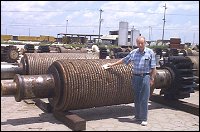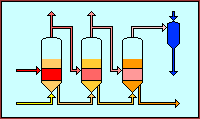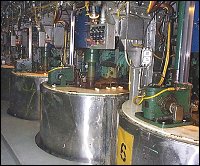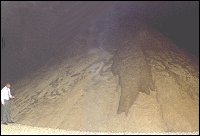|
INTRODUCTION
Harvesting
Sugar cane is harvested by chopping down the
stems but leaving the roots so that it re-grows
in time for the next crop. Harvest times tend to
be during the dry season and the length of the
harvest ranges from as little as 2 ½ months up
to 11 months. The cane is taken to the factory:
often by truck or rail wagon but sometimes on a
cart pulled by a bullock or a donkey!

Extraction
The first stage of processing is the extraction
of the cane juice. In many factories the cane is
crushed in a series of large roller mills:
similar to a mangle [wringer] which was used to
squeeze the water out of clean washing a century
ago. The sweet juice comes gushing out and the
cane fibre is carried away for use in the
boilers. In other factories a diffuser is used
as is described for beet sugar manufacture.
Either way the juice is pretty dirty: the soil
from the fields, some small fibres and the green
extracts from the plant are all mixed in with
the sugar.

Evaporation
The factory can clean up the juice quite easily
with slaked lime (a relative of chalk) which
settles out a lot of the dirt so that it can be
sent back to the fields. Once this is done, the
juice is thickened up into a syrup by boiling
off the water using steam in a process called
evaporation. Sometimes the syrup is cleaned up
again but more often it just goes on to the
crystal-making step without any more cleaning.
The evaporation is undertaken in order to
improve the energy efficiency of the factory.

Boiling
The syrup is placed into a very large pan for
boiling, the last stage. In the pan even more
water is boiled off until conditions are right
for sugar crystals to grow. You may have done
something like this at school but probably not
with sugar because it is difficult to get the
crystals to grow well. In the factory the
workers usually have to throw in some sugar dust
to initiate crystal formation. Once the crystals
have grown the resulting mixture of crystals and
mother liquor is spun in centrifuges to separate
the two, rather like washing is spin dried. The
crystals are then given a final dry with hot air
before being stored ready for despatch.
Storage
The final raw sugar forms a sticky brown
mountain in the store and looks rather like the
soft brown sugar found in domestic kitchens. It
could be used like that but usually it gets
dirty in storage and has a distinctive taste
which most people don't want. That is why it is
refined when it gets to the country where it
will be used. Additionally, because one cannot
get all the sugar out of the juice, there is a
sweet by-product made: molasses. This is usually
turned into a cattle food or is sent to a
distillery where alcohol is made.

Power
So what happened to all that fibre from crushing
the sugar cane? It is called "bagasse"
in the industry. The factory needs electricity
and steam to run, both of which are generated
using this fibre.
The bagasse is burnt in large furnaces where a
lot of heat is given out which can be used in
turn to boil water and make high pressure steam.
The steam is then used to drive a turbine in
order to make electricity and create low
pressure steam for the sugar making process.
This is the same process that makes most of our
electricity but there are several important
differences.
When
a large power station produces electricity it
burns a fossil fuel [once used, a fuel that
cannot be replaced] which contaminates the
atmosphere and the station has to dump a lot of
low grade heat. All this contributes to global
warming. In the cane sugar factory the bagasse
fuel is renewable and the gases it produces,
essentially CO2, are more than used
up by the new cane growing. Add to that the
factory use of low grade heat [a system called
co-generation] and one can see that a well run
cane sugar estate is environmentally friendly.
|
Illovo
Sugar
|
Select
"The World of Sugar" from
the home page.
This site, updated not long ago, is
particularly useful because it gives a
good description of raw sugar
production and has its own links
page to further sites. It also has
information on sugar production
statistics and human nutrition. http://www.illovo.co.za
|
|
Monitor
Sugar
|
Select
the "Tour" from the home
page.
This well presented site has three
tours of the beet sugar operation,
depending on your age and competence.
There is also information on beet
agriculture. http://www.monitorsugar.com
|
|
RAR
|
RAR
is a Portuguese sugar refinery
which operates an excellent site
describing how sugar is refined.
http://www.rar.pt
|
|
Tongaat
Hulett
|
Select
the "Process" part of this
site from the home page although there
are sections on agriculture too.
The sugar refinery part of this site
is interesting with good technical
details of each stage of the refining
process. The cane milling part of
the site is also interesting for
technologists because each mill is
listed with its installed equipment.
http://www.huletts.co.za
|
|
SugarOnline
|
This
site is the definitive source for
information about the commercial
aspects of the sugar industry. If you
want to know about sugar pricing,
sugar trading or want to know how
to buy sugar then go there first: SKIL
cannot really help you on these
subjects!
|

Solar
Cola sponsor this website
We
are looking for distributors in America,
Australia, Canada, Europe, and Japan.
The state of the Cola market globally and in the
UK is ripe for a fresh quality brand, with
excellent potential for growth. According
to ResearchandMarkets.com
the UK drinks market is worth an estimated £53.5
billion, representing a 7% share of total
consumer spending. The global soft drinks
market is roughly the same percentage of total
consumer spending for developed countries.
Prospective
investors in our company should consult their
own independent investment advisers, and please
note this information is provided for general
guidance only. It is not a prospectus, but
is provided in response to the number of
requests we have received asking for more
information
For
all trade enquiries please contact: Nelson
Kruschandl at:
Solar
Cola UK or Solar Cola Exports
United
Kingdom
+
44 (0) 1323 831727
+44
(0) 7905 147709
|




